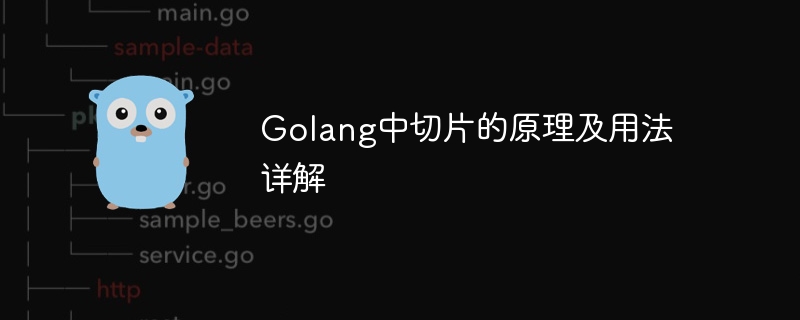

Detailed explanation of the principle and usage of slicing in Golang
In the Golang language, slice (slice) is a very important and commonly used data structure. Slice is a kind of encapsulation of array and can be regarded as a dynamic array. Compared with arrays, slices have variable lengths and do not need to specify the array size, which is very convenient and flexible in actual development. This article will deeply explore the principles and usage of slicing in Golang, and explain it with specific code examples.
In Golang, a slice is a data structure composed of three parts: pointer, length and capacity. Among them, the pointer points to the address of the first element of the array, the length indicates the number of elements of the slice, and the capacity refers to the maximum expansion capacity of the slice. The bottom layer of slicing is implemented by an array, and the slicing function is implemented by cutting the array.
// 声明并初始化一个切片
var slice1 []int
slice1 = []int{1, 2, 3}
// 简化的切片声明和初始化方式
slice2 := []int{4, 5, 6}
// 通过make函数创建切片,参数为类型、长度和容量
slice3 := make([]int, 3, 5)Access and modification of slices
slice := []int{1, 2, 3}
fmt.Println(slice[0]) // 输出 1
slice[1] = 4
fmt.Println(slice) // 输出 [1 4 3]Append to slice
slice := []int{1, 2, 3}
slice = append(slice, 4, 5)
fmt.Println(slice) // 输出 [1 2 3 4 5]Copy of slice
slice1 := []int{1, 2, 3}
slice2 := make([]int, 3)
copy(slice2, slice1)
fmt.Println(slice2) // 输出 [1 2 3]Cut of slice
slice := []int{1, 2, 3, 4, 5}
newSlice := slice[1:3] // 切片的下标是左闭右开区间
fmt.Println(newSlice) // 输出 [2 3]When the slice capacity is insufficient, the append function will trigger the expansion operation. The bottom layer of Golang will reallocate a larger underlying array and copy the original data to the new array. When expanding, the capacity will generally double, which can reduce performance consumption caused by frequent expansion.
Slices are reference types. When passed as function parameters, they are passed by reference. Modifying the slice content will affect the value of the original slice.
Summary: Slicing is a very important data structure in Golang, which is flexible and efficient. It is crucial for Golang developers to be proficient in the principles and usage of slicing. Through the detailed explanation and code examples in this article, I believe readers will have a deeper understanding of slicing in Golang. I hope readers can flexibly apply slicing in actual development to improve code quality and efficiency.
The above is a detailed explanation of the principle and usage of slicing in Golang. I hope it will be helpful to you.
The above is the detailed content of Detailed explanation of the principle and usage of slicing in Golang. For more information, please follow other related articles on the PHP Chinese website!
 How to define variables in golang
How to define variables in golang
 What are the data conversion methods in golang?
What are the data conversion methods in golang?
 What are the commonly used libraries in golang?
What are the commonly used libraries in golang?
 What is the difference between golang and python
What is the difference between golang and python
 What is the difference between TCP protocol and UDP protocol?
What is the difference between TCP protocol and UDP protocol?
 Introduction to reasons why remote desktop cannot connect
Introduction to reasons why remote desktop cannot connect
 ingress
ingress
 Reasons why Windows printer does not print
Reasons why Windows printer does not print




